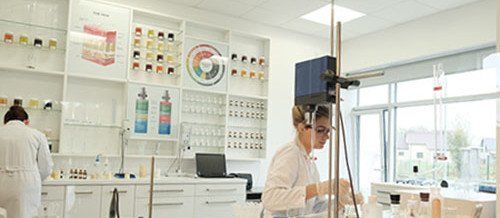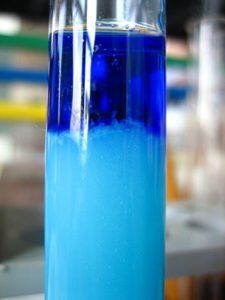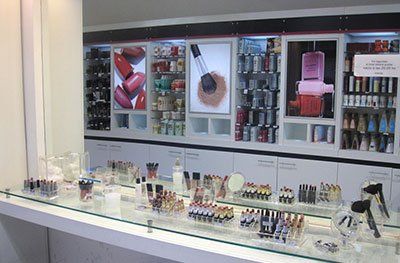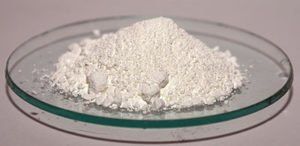What Makes Up YOUR Makeup?
- By J.Maxine MacGwyre, LMA, Nutrition Specialist
- •
- 11 Apr, 2019
- •

More than ever, consumers are taking a more active role in their health care, and have become more ingredient savvy than ever before; paying attention to ingredients we are putting both into AND on our bodies. This trend is making its way into the world of skincare with clients wanting to know about the health impacts of ingredients they’re putting on their skin as well as where those ingredients have been sourced.
While more clients have become increasingly aware of what is in their skin and body serums, sun protection formulas, what’s being applied in the treatment room, and how food impacts the health of their skin, that same level of awareness tends not to extend to the cosmetics in our makeup bags. There has been momentum in awareness to look for products that say “paraben free” or that don’t test on animals, but most don’t take a hard look at the ingredient deck of their makeup products because, frankly, it’s a bit overwhelming!
Suffice to say, it might be worth revisiting the products you’ve been using— you will find that…
All ingredients aren’t created equal.
So in a good, better, best scenario, we have over-the-counter (OTC) drugstore brands, OTC premium brands, and Cosmeceutical Mineral Makeup available through professionals only.
Generally speaking, raw materials that go into product formulations are sourced from different countries and may be extracted from natural sources or synthesized in the laboratory.

Typically, the mass-market brands like CoverGirl or Revlon incorporate more synthetic and less expensive ingredients into their products. On the other hand, high-end products, like MAC, Bobbi Brown and many Multi-Level Marketing (MLM) brands, often have premium formulations, higher quality ingredients, more pigment, and include more costly technologies in the creation of those products. Frequently, high-end makeup has cleaner ingredients, fewer fillers, and a range of shades to suit your skin’s individual needs, and they may have a performance advantage over their drugstore counterparts.
Most consumers look at how well makeup performs in terms of enhancing or downplaying certain facial features rather than looking to their makeup to affect change in the skin.
BUT from an aesthetician’s perspective, makeup isn’t just about covering up. Think about it, makeup is typically on the skin for a significant amount of time throughout the day, and in many cases, every day of the week. Considering skin is a living, breathing organ, you can bet that anything on it for that long of a stretch most definitely will impact the overall health of the skin…for good or bad. The right ingredients in cosmetics will continue the work done in the treatment room just as much as quality skincare products. After all, makeup can and should be a continuation of good skincare…enter Cosmeceutical Mineral Makeup. But first…
Decoder ring for typical ingredients found in OTC cosmetics
The cosmetic industry traditionally has not shared safety data when it came to chemical ingredients used in the products. Though it’s improved over the years, there are still a number of OTC cosmetic brands using harsh chemicals, parabens and fragrances in their foundations, powders, mascaras, eyeshadows and lip products. Many of these actually present a threat to the skin…never mind the large number of manufacturers still testing on animals.

Among the most common harmful ingredients used are sodium lauryl sulfate, parabens, synthetic colorants, polyethylene glycol (PEG), petroleum distillates, formaldehyde and fragrance. Let’s explore each more closely:
Sodium lauryl sulfate (SLS). SLS is an emulsifier and foaming agent most commonly found in cleansers, washes, shampoos, soaps and laundry detergent, as it is responsible for that “sudsy” effect we’ve come to associate with in soap. However, it’s also found in various makeup products such as mascara, despite it being a known skin and eye irritant.
Polyethylene glycol (PEG). PEG is used in makeup products including eyeliners, mascaras, eye shadows, lipsticks and powders, to name a few. Polyethylene is a type of plastic, and while it has been deemed a low hazard ingredient for cancer, it has been shown to penetrate the skin and cause skin irritation.
Formaldehyde. Formaldehyde and formaldehyde-releasing preservatives are used to prevent bacteria growth in water-based products. Though formaldehyde is a naturally occurring organic compound, most of what is being used in the products we use is produced industrially and has been recognized as a human carcinogen, as well as an ingredient that commonly causes allergic skin reactions.
Parabens. These widely used preservatives extend shelf life of products. Typically, products will use more than one type of paraben and among those most commonly used are methylparaben, propylparaben, butylparaben and ethylparaben. Parabens prevent bacteria, mold and yeast from growing in cosmetic products. While there continues to be ongoing research into the true effects of parabens, they have been found to contain estrogen-mimicking properties that have been linked to certain forms of cancer.
Petroleum distillates. This group of ingredients are typically found in foundations, lotions, mascara, etc. to provide fragrance and lock in moisture. They are hydrocarbon solvents produced from crude oil that have been found to contain cancer-causing impurities and are most often produced in oil refineries that produce automobile fuel. According to some research, they are of high concern with regards to toxicity, and they’re a known skin and eye irritant.

Fragrance. Fragrance is somewhat of a catchall term that allows manufacturers to get away with creating rather ambiguous or secret formulas. Often, these concoctions contain hormone disruptors and various chemicals, and are among the top allergic-reaction triggers. They’re found in everything from perfumes to lotions to cleansers and beyond.
Synthetic vitamin E. Found in many makeup products (designated with a “dl” prefix), it has been shown to create free radicals in the skin. A study in the early 2000s, revealed that the synthetic form of vitamin E produces negative effects on the skin and body and is not as easily synthesized as the natural version.
Sunscreen chemicals. While avobenzone, oxybenzone and octinoxate are widely debated, some research has shown these chemical blockers actually absorb UV light, which may exacerbate the problem they were aiming to solve in the first place. Additionally, they are highly absorbable by the skin, and have also been found to be endocrine disruptors. Many manufacturers have started adding sunscreen to their cosmetics, which in theory is a good thing, however, consumers need to look for products containing a natural mineral blocker: zinc oxide or titanium dioxide.
These are just a few of the chemical ingredients that have made their way into cosmetics over the years. While the impacts of many of these are still widely debated, it is best to eliminate as many potential irritants as possible to achieve optimal skin health. Luckily, today there are more natural alternatives available.
Health-promoting Cosmeceutical Mineral Cosmetics
Makeup has evolved significantly over the years, as manufacturers and researchers have discovered healthier, anti-aging alternative ingredients. Through advancements in ingredients and distillation processes, it is now possible to have BEAUTYfull ® AND healthy skin. In fact, many of the ingredients we’re using in the treatment room and prescribed home care also make for ideal ingredients in cosmetic products. Antioxidants, natural minerals, vitamins, and omega essential fatty acids are now being incorporated into beauty counter products like foundations, powders and lip glosses to further support optimal skin health.

Why Minerals?
A mineral is an inorganic, solid material that occurs naturally in rocks and in the ground. When these compounds are used in cosmetics, they help smooth the appearance of fine lines and blemishes by reflecting light. The natural pigments from the earth, such as iron oxides, provide rich color naturally unlike traditional makeup formulas, which utilize harmful petroleum dyes, pore-clogging talc and other chemical-based additives.
Minerals also naturally provide sun protection, dry zinc and titanium dioxide, to keep skin healthy and youthful. Minerals don’t support the growth of bacteria or microbes, and thus pose a lower risk of allergic reaction. Additionally, minerals can even be used on skin recovering from harsh medical procedures, as well as on problem skin conditions like rosacea, acne and discoloration.
At SkinRevision we exclusively recommend pharmaceutical grade mineral cosmetics using the best of what our earth has to offer. All natural, cruelty-free, healing and non-comedogenic: Jill Adelyn Cosmetics, Lira Clinical BB Cremes and RevitaLash.
The following are a few healthy skin-promoting ingredients found in Cosmeceutical Cosmetics:
Bismuth oxychloride. Found in mineral makeup, bismuth oxychloride is responsible for that pearly, iridescent look. It is an inorganic compound naturally found in the mineral bismoclite. It provides a smooth, luxurious feel and is the key ingredient that helps keep powder looking fresh all day.
Mica. A light, natural, silicate mineral, this is another ingredient that helps give the skin that luminous glow and iridescence.
Boron nitride. An ultra-trace mineral, boron nitride is an essential plant nutrient found in various crystalline forms. It improves the application of the mineral foundation and adheres to the skin for long-lasting wear.
Tapioca powder. We commonly see this in foods; however, it is also a great alternative thickening agent in cosmetics. It is a natural starch extract from the cassava root and is responsible for giving powder a light feel on the skin.
Carrot seed extract. Carrot seed provides antioxidant, antiseptic and beta-carotene support and is known to help sensitive skin. A natural alternative to other manufactured moisturizing agents, it provides hydration and is a known rejuvenator, bringing new life to the skin.
Squalane. A naturally occurring lipid in plants, squalane supports the skin in retaining moisture and guards against UV radiation.
Zinc oxide. This non-irritating, broad spectrum, UV absorbing protects and soothes skin and provides healing relief. A far superior alternative to chemical blockers.

Cetearyl olivate/ sorbitan olivate. A unique biomimetic restructuring agent from pure olive oil that restores and maintains the integrity of the skin barrier, and gives tonicity and elasticity to the skin. It also reduces inflammation, helps carry other active ingredients into the deeper epidermal layers, and protects skin from harsh environmental assaults and UV rays. It’s another healthy alternative to other moisturizing agents and provides brilliance to the skin.
Natural wax complex. A complex of sunflower seed, candelilla, beeswax and orange peel is a natural, emulsifying wax great for use in lip gloss, as it traps in moisture and defends skin from environmental assaults without clogging pores. It also is an anti-inflammatory, rich in nutrients and phytosterol support that prevents damage to cells, and protects collagen and elastin production.
These are just a few of the natural ingredients being used in place of many of the chemical-laden ingredients that have been so common in the cosmetic industry until now. In addition to being safer alternatives for giving the products the desired consistency and feel, these ingredients also deliver skin-health promoting benefits.
And there you have it
The benefits of makeup don’t have to be limited to covering up or accentuating our features; it can now support taking skin all the way to the finish line of optimal health.
We have to take into consideration the entire ingredient deck, as well as the manufacturing process. To determine the true formulation from the ingredient deck, you’ll want to read it through to the end. You may see one of the above mentioned healthy ingredients, but then it may be filled with other potentially harmful or low-quality ingredients. Also look at the placement of the ingredients. If the healthy ingredients are listed at the bottom of the deck, they really won’t make much of an impact.
We all want to get the most value out of the money we spend on our skin health and putting our best face forward!




